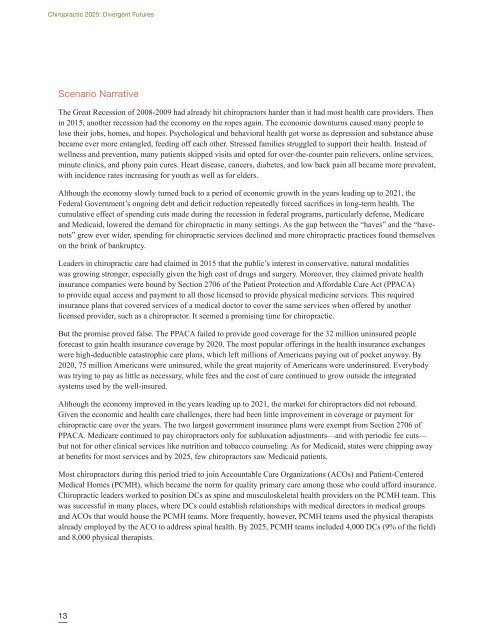Chiropractic 2025:
Chiropractic 2025:
Chiropractic 2025:
Create successful ePaper yourself
Turn your PDF publications into a flip-book with our unique Google optimized e-Paper software.
<strong>Chiropractic</strong> <strong>2025</strong>: Divergent Futures<br />
Scenario Narrative<br />
The Great Recession of 2008-2009 had already hit chiropractors harder than it had most health care providers. Then<br />
in 2015, another recession had the economy on the ropes again. The economic downturns caused many people to<br />
lose their jobs, homes, and hopes. Psychological and behavioral health got worse as depression and substance abuse<br />
became ever more entangled, feeding off each other. Stressed families struggled to support their health. Instead of<br />
wellness and prevention, many patients skipped visits and opted for over-the-counter pain relievers, online services,<br />
minute clinics, and phony pain cures. Heart disease, cancers, diabetes, and low back pain all became more prevalent,<br />
with incidence rates increasing for youth as well as for elders.<br />
Although the economy slowly turned back to a period of economic growth in the years leading up to 2021, the<br />
Federal Government’s ongoing debt and deficit reduction repeatedly forced sacrifices in long-term health. The<br />
cumulative effect of spending cuts made during the recession in federal programs, particularly defense, Medicare<br />
and Medicaid, lowered the demand for chiropractic in many settings. As the gap between the “haves” and the “havenots”<br />
grew ever wider, spending for chiropractic services declined and more chiropractic practices found themselves<br />
on the brink of bankruptcy.<br />
Leaders in chiropractic care had claimed in 2015 that the public’s interest in conservative, natural modalities<br />
was growing stronger, especially given the high cost of drugs and surgery. Moreover, they claimed private health<br />
insurance companies were bound by Section 2706 of the Patient Protection and Affordable Care Act (PPACA)<br />
to provide equal access and payment to all those licensed to provide physical medicine services. This required<br />
insurance plans that covered services of a medical doctor to cover the same services when offered by another<br />
licensed provider, such as a chiropractor. It seemed a promising time for chiropractic.<br />
But the promise proved false. The PPACA failed to provide good coverage for the 32 million uninsured people<br />
forecast to gain health insurance coverage by 2020. The most popular offerings in the health insurance exchanges<br />
were high-deductible catastrophic care plans, which left millions of Americans paying out of pocket anyway. By<br />
2020, 75 million Americans were uninsured, while the great majority of Americans were underinsured. Everybody<br />
was trying to pay as little as necessary, while fees and the cost of care continued to grow outside the integrated<br />
systems used by the well-insured.<br />
Although the economy improved in the years leading up to 2021, the market for chiropractors did not rebound.<br />
Given the economic and health care challenges, there had been little improvement in coverage or payment for<br />
chiropractic care over the years. The two largest government insurance plans were exempt from Section 2706 of<br />
PPACA. Medicare continued to pay chiropractors only for subluxation adjustments—and with periodic fee cuts—<br />
but not for other clinical services like nutrition and tobacco counseling. As for Medicaid, states were chipping away<br />
at benefits for most services and by <strong>2025</strong>, few chiropractors saw Medicaid patients.<br />
Most chiropractors during this period tried to join Accountable Care Organizations (ACOs) and Patient-Centered<br />
Medical Homes (PCMH), which became the norm for quality primary care among those who could afford insurance.<br />
<strong>Chiropractic</strong> leaders worked to position DCs as spine and musculoskeletal health providers on the PCMH team. This<br />
was successful in many places, where DCs could establish relationships with medical directors in medical groups<br />
and ACOs that would house the PCMH teams. More frequently, however, PCMH teams used the physical therapists<br />
already employed by the ACO to address spinal health. By <strong>2025</strong>, PCMH teams included 4,000 DCs (9% of the field)<br />
and 8,000 physical therapists.<br />
13


